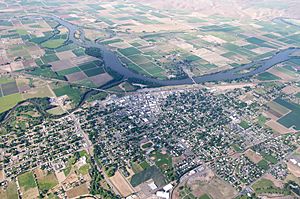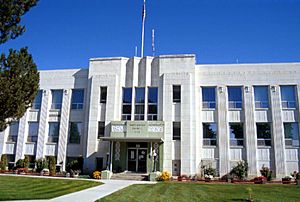Weiser, Idaho facts for kids
Quick facts for kids
Weiser, Idaho
|
|
|---|---|
|
City
|
|

Weiser in May 2009
|
|

Location of Weiser in Washington County, Idaho.
|
|
| Country | United States |
| State | Idaho |
| County | Washington |
| Area | |
| • Total | 2.99 sq mi (7.75 km2) |
| • Land | 2.98 sq mi (7.72 km2) |
| • Water | 0.01 sq mi (0.03 km2) |
| Elevation | 2,149 ft (655 m) |
| Population
(2010)
|
|
| • Total | 5,507 |
| • Density | 1,803.42/sq mi (696.22/km2) |
| Time zone | UTC−7 (Mountain (MST)) |
| • Summer (DST) | UTC−6 (MDT) |
| ZIP code |
83672
|
| Area code | 208, 986 |
| FIPS code | 16-86140 |
| GNIS feature ID | 2412206 |
Weiser (pronounced WEE-zər) is a city in Idaho. It's the main city of Washington County. Weiser has a mild climate. This helps local farms, orchards, and livestock. The city is where the Weiser River meets the big Snake River. The Snake River forms the border with Oregon. In 2010, about 5,507 people lived here.
Contents
Weiser's Past: A Look at History
Weiser city got its name from the Weiser River. People are not sure exactly who the river was named after. One idea is Peter M. Weiser. He was a soldier with the Lewis and Clark Expedition (1804–1806). Another idea is Jacob Weiser. He was a trapper who found a lot of gold in Idaho in 1861.
The first white settlers near Weiser were William and Nancy Logan in 1863. They built a roadhouse. This was for travelers using Olds Ferry nearby. Reuben Olds started Olds Ferry in 1863. The ferry business did well. It helped bring more people to the Weiser River valley. A post office opened in 1866 as Weiser Ranch. In 1871, it was renamed Weiser.
Weiser grew a lot when a railroad station was built. It became a busy place for travel. Many old buildings from the 1890s and early 1900s are still standing. They are now on the National Register of Historic Places. This shows Weiser's rich history.
In the 1890s, Weiser hoped to become a major trade and transport center. The Idaho Northern Railroad was built up the Weiser River. It was meant to reach Lewiston and connect to ocean shipping. But the railroad stopped in central Idaho. It ended near the town of Meadows. A new city, New Meadows, was created there. Also, the Union Pacific railroad chose not to build its main yards near Weiser. They built them in Huntington, Oregon instead.
Hall of Fame pitcher Walter Johnson played semi-pro baseball for the Weiser Kids. This was in 1906–1907. He was a young man then. After high school, he came to Weiser to play baseball. He also worked for the local phone company. While in Weiser, he once pitched 84 games without letting the other team score. His amazing skills caught the eye of the Washington Nationals. They offered him a contract. In July 1907, he left Idaho for the major leagues at age nineteen.
U.S. Route 95 goes through Weiser. This road connects the city to Oregon and British Columbia.
Weiser's Culture: Fiddles and Fun
Weiser is known as the "Fiddling Capital of the World." The National Oldtime Fiddlers' Contest has been held here every year since 1953. Fiddling contests have happened in Weiser since 1914. The current festival was the idea of Blaine Stubblefield. He was a fiddler and folk music fan. He was also the head of the city's business group.
The festival takes place in late June. It brings in national news and over 7,000 people. The city also has a local weekly newspaper called the Weiser Signal-American.
For many years, Weiser was the starting point for tours down Hells Canyon. People would go on rubber raft trips. Big sturgeon and many salmon attracted people who liked to fish. But the salmon runs ended. This happened after three dams were built on the river starting in the 1950s.
Weiser's Location and Climate
Weiser covers about 3.38 square miles (7.75 square kilometers). All of this area is land. Annex, Oregon, is a small community across the Snake River from Weiser.
Weiser's Weather Patterns
Weiser has a semi-arid climate. This means it has cold winters. Summers are hot and dry.
| Climate data for Weiser, Idaho, 1991–2020 normals, extremes 1911–2012 | |||||||||||||
|---|---|---|---|---|---|---|---|---|---|---|---|---|---|
| Month | Jan | Feb | Mar | Apr | May | Jun | Jul | Aug | Sep | Oct | Nov | Dec | Year |
| Record high °F (°C) | 65 (18) |
67 (19) |
83 (28) |
93 (34) |
104 (40) |
110 (43) |
115 (46) |
110 (43) |
107 (42) |
97 (36) |
73 (23) |
64 (18) |
115 (46) |
| Mean maximum °F (°C) | 47.2 (8.4) |
55.1 (12.8) |
70.1 (21.2) |
80.3 (26.8) |
91.6 (33.1) |
97.9 (36.6) |
103.3 (39.6) |
101.5 (38.6) |
93.5 (34.2) |
81.3 (27.4) |
62.4 (16.9) |
50.2 (10.1) |
104.5 (40.3) |
| Mean daily maximum °F (°C) | 36.2 (2.3) |
44.4 (6.9) |
56.7 (13.7) |
64.3 (17.9) |
74.4 (23.6) |
83.5 (28.6) |
94.5 (34.7) |
91.8 (33.2) |
80.8 (27.1) |
65.1 (18.4) |
48.0 (8.9) |
36.8 (2.7) |
64.7 (18.2) |
| Daily mean °F (°C) | 29.4 (−1.4) |
35.3 (1.8) |
44.8 (7.1) |
51.4 (10.8) |
60.6 (15.9) |
68.5 (20.3) |
77.8 (25.4) |
75.4 (24.1) |
64.9 (18.3) |
51.3 (10.7) |
38.2 (3.4) |
29.7 (−1.3) |
52.3 (11.3) |
| Mean daily minimum °F (°C) | 22.5 (−5.3) |
26.3 (−3.2) |
32.9 (0.5) |
38.5 (3.6) |
46.8 (8.2) |
53.4 (11.9) |
61.1 (16.2) |
59.0 (15.0) |
49.0 (9.4) |
37.6 (3.1) |
28.5 (−1.9) |
22.5 (−5.3) |
39.8 (4.4) |
| Mean minimum °F (°C) | 2.7 (−16.3) |
7.7 (−13.5) |
20.1 (−6.6) |
25.9 (−3.4) |
30.7 (−0.7) |
39.3 (4.1) |
47.0 (8.3) |
46.2 (7.9) |
33.5 (0.8) |
23.0 (−5.0) |
15.1 (−9.4) |
4.8 (−15.1) |
−2.9 (−19.4) |
| Record low °F (°C) | −27 (−33) |
−29 (−34) |
0 (−18) |
16 (−9) |
22 (−6) |
23 (−5) |
34 (1) |
32 (0) |
16 (−9) |
11 (−12) |
−13 (−25) |
−28 (−33) |
−29 (−34) |
| Average precipitation inches (mm) | 1.96 (50) |
1.34 (34) |
1.22 (31) |
1.07 (27) |
1.29 (33) |
1.04 (26) |
0.35 (8.9) |
0.26 (6.6) |
0.40 (10) |
0.83 (21) |
1.32 (34) |
2.37 (60) |
13.45 (341.5) |
| Average snowfall inches (cm) | 6.9 (18) |
2.4 (6.1) |
0.4 (1.0) |
trace | 0.0 (0.0) |
0.0 (0.0) |
0.0 (0.0) |
0.0 (0.0) |
0.0 (0.0) |
0.0 (0.0) |
0.9 (2.3) |
9.1 (23) |
19.7 (50.4) |
| Average precipitation days (≥ 0.01 in) | 11.0 | 9.4 | 10.2 | 9.6 | 7.6 | 6.8 | 2.6 | 2.5 | 2.7 | 5.1 | 10.6 | 12.1 | 90.2 |
| Average snowy days (≥ 0.1 in) | 4.5 | 2.0 | 0.5 | 0.0 | 0.0 | 0.0 | 0.0 | 0.0 | 0.0 | 0.0 | 0.9 | 4.5 | 12.4 |
| Source 1: NOAA (snow/snow days 1981–2010) | |||||||||||||
| Source 2: National Weather Service (mean maxima/minima 1981–2010) | |||||||||||||
Weiser's Economy and Jobs
As of 2018, jobs at the hospital and school system often need a college degree. Most other jobs in Weiser do not require a university education.
Weiser's People: Demographics
| Historical population | |||
|---|---|---|---|
| Census | Pop. | %± | |
| 1890 | 901 | — | |
| 1900 | 1,364 | 51.4% | |
| 1910 | 2,600 | 90.6% | |
| 1920 | 3,154 | 21.3% | |
| 1930 | 2,724 | −13.6% | |
| 1940 | 3,663 | 34.5% | |
| 1950 | 3,961 | 8.1% | |
| 1960 | 4,208 | 6.2% | |
| 1970 | 4,108 | −2.4% | |
| 1980 | 4,771 | 16.1% | |
| 1990 | 4,571 | −4.2% | |
| 2000 | 5,343 | 16.9% | |
| 2010 | 5,507 | 3.1% | |
| 2019 (est.) | 5,376 | −2.4% | |
| U.S. Decennial Census | |||
Weiser's Population in 2020
In 2020, there were 5,630 people living in Weiser. There were 2,101 households and 1,349 families.
| Race | Number | Percentage |
|---|---|---|
| White (NH) | 3,804 | 67.57% |
| Black or African American (NH) | 9 | 0.16% |
| Native American or Alaska Native (NH) | 47 | 0.83% |
| Asian (NH) | 51 | 0.91% |
| Pacific Islander (NH) | 3 | 0.05% |
| Some Other Race (NH) | 26 | 0.46% |
| Mixed/Multi-Racial (NH) | 269 | 4.78% |
| Hispanic or Latino | 1,421 | 25.24% |
| Total | 5,630 |
Weiser's Population in 2010
In 2010, Weiser had 5,507 people. There were 2,158 households. About 1,396 families lived in the city. The city had about 1,629 people per square mile. There were 2,355 homes.
Most people (80.8%) were White. About 14.3% were from other races. About 26.1% of the people were Hispanic or Latino.
About 33.4% of households had children under 18. About 46.2% were married couples. The average household had 2.50 people. The average family had 3.11 people.
The average age in Weiser was 38.7 years. About 26.4% of people were under 18. About 18.7% were 65 or older. The city was 48.4% male and 51.6% female.
Weiser's Schools and Learning
Weiser is part of the Weiser School District 431. The district has several schools:
- Pioneer Elementary School (Kindergarten, 1st, 2nd, and 3rd grades)
- Park Intermediate School (4th and 5th grades)
- Weiser Middle School (6th, 7th, and 8th grades)
- Weiser High School (9th, 10th, 11th, and 12th grades)
The first school in Weiser opened in 1867. The first school building was built in 1882. A special building for the high school opened in 1904. Weiser Academy, also called Intermountain Institute, was a boarding school. It was started by Edward Paddock. In the 1930s, part of the school was used by the National Youth Administration. In 1948, the entire boarding school property was given to the high school.
Washington County is near the College of Western Idaho. This college has its main campus in Nampa.
Famous People from Weiser
- Roger Batzel – Director of Lawrence Livermore National Laboratory
- George Donart – Politician
- Walter Johnson – Famous Baseball Hall of Fame player
- Bob Martyn – Baseball player
- M. C. Richards – Poet, potter, and teacher
- Harold Ryan – U.S. District Judge
- Kevin Sharp – Country music singer
- Jane Slocum – Educator and lecturer
- Blaine Stubblefield – Country singer and poet
- Herman Welker – U.S. Senator from Idaho
- Tim Wrightman – Super Bowl XX Champion with the 1985 Chicago Bears
See also
 In Spanish: Weiser (Idaho) para niños
In Spanish: Weiser (Idaho) para niños



